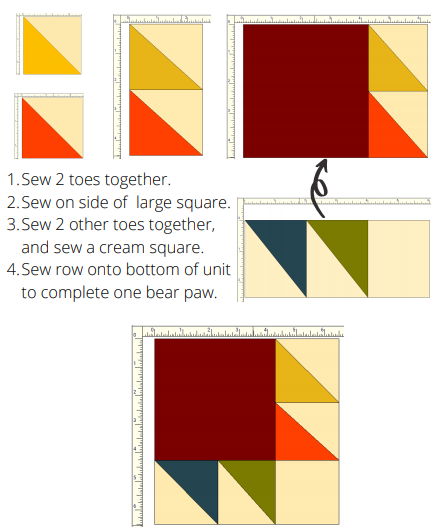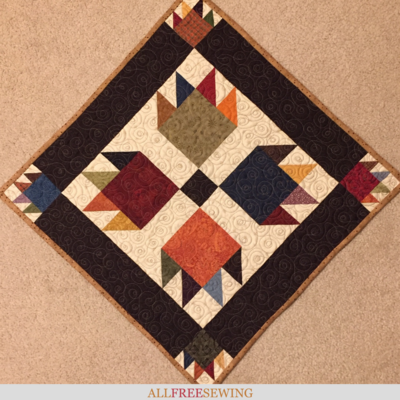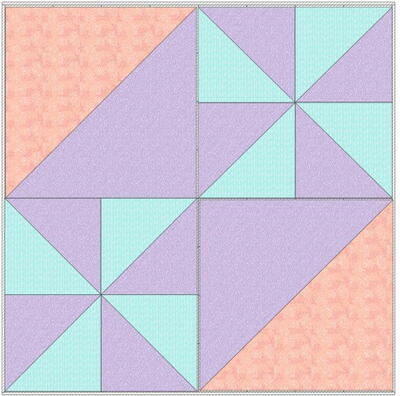Miniature Bear's Paw Quilt Pattern
This is one of the most beautiful bear paw quilt block variations we've seen. Learn how to make your own mini quilt!
This easy, scrappy, mini Barefoot Quilt is a play on words with the Bear Paw blocks it uses! My absolute favorite is to be barefoot and this quilt reflects that quality of life. Measuring 20” x 20”, the miniature bear's paw quilt pattern results in a cute quilt that's the perfect size to decorate a table. Or add a sleeve to the back and hang this barefoot up!
Based on a classic quilting technique, the Barefoot Quilt is a great project for a beginning quilter. There's nothing too complicated about the pattern but the results are eye-catching and magnificent. This quilt can easily be made in a day or over the weekend, too.
Because the top includes 4-1/2” squares or smaller, you can either purchase small amounts of fabric or just use scraps to create this quilted beauty. If you're used to designing your own quilts or doctoring up existing patterns, you'll have fun changing up the colors on this one to match the season or colors you want to use.
Plus, scroll down to download the PDF version of this full mini quilt pattern.
General Sewing Directions for This Mini Quilt
The directions for this Barefoot Quilt are for rotary cutting, machine piecing, machine quilting, and the binding is hand-stitched to the quilt back.
Accurate cutting and sewing enhances your final product. Pin your pieces together before sewing them to ensure proper seam alignment.
Use a 1/4” seam allowance. I recommend using a special presser foot with a 1/4” guide if you have one for your machine. This will help you get uniform seams, and matching corners!
Follow the directions described below as you press open the seams to eliminate bulk and help seams to lay flat.
The pattern calls for machine quilting, but this quilt is so small you could easily hand quilt it.
The finished quilt measures 20”x 20”.
This scrappy, mini Barefoot Quilt is so “pawfully” cute, it’ll steal your heart! It doesn’t take much fabric at all to make. Carefully read through all the information below on how to make this mini quilt.
Mini Bear's Paw Quilt Fabric Requirements
I used a variety of fall-colored prints for the Barefoot Quilt. There are no rules, use any color you love or a variety of your favorite colors!
Colored Fabric for Bear Claws: The total fabric needed is about 2/3 yard. However, to achieve the scrappy look of this quilt I suggest using at least 10-12 different prints. Either raid your stash or purchase a few new fat quarters.
Cream Fabric for Paw Background and Sashing: The total fabric needed is 1/4 yard. I used one cream pattern, but for an even scrappier look, you could vary the cream prints.
Backing Fabric: 2/3 yard of fabric
Binding Fabric: 1/4 yard of fabric
Batting: You'll need a piece of 24" x 24" thin cotton batting (like Warm & Natural) to make this quilt.
Mini Bear's Paw Quilt Cutting Directions
Big Bear Paws Colored Fabric: Cut 4 – 4-1/2” squares, and 16 – 2-1/2” squares
Little Bear Paws Colored Fabric: Cut 4 – 2-1/2” squares, and 16 – 1-1/2” squares
Cream Fabric: For big paws cut 20 – 2-1/2” squares, for small paws cut 20 – 1-1/2” squares, for sashing cut 4 – 2-1/2” x 6-1/2” rectangles
Quilt Back: Cut 1 - 24" x 24" square for the back
Binding: Cut 3 – 2-1/2” x 44” strips, trim the ends of each strip at opposing 45-degree angles
Batting: Cut 1 - 24" x 24" square
Sewing the Bear Paw Blocks
Set 4 of the 2-1/2” cream blocks aside, you’ll use them to complete the block later.
Now, begin by sewing all the toes!
Completing the toes are accomplished by sewing each of the 16 – 2-1/2” colored squares to a 2-1/2” cream square. This will be creating 16 – “half square triangle” blocks.
To do this, lightly draw a diagonal line on the wrong side of 12 of the 2-1/2” square blocks with a fine pencil.
Place the right side of a colored 2-1/2” block and the right side of a cream block together. With the diagonal line facing up, sew along the line. Trim 1/4” from the seam. Press open toward the colored side. This half square triangle block should again measure to be a 2-1/2” square.
Repeat this process for each of the 16 big toes, and for the 16 little toes.
Now that you have all of the toes sewn together, arrange them on your table or design wall to put each colored block and toe in a place you like. You can follow the block color layout as shown in the pattern, or veer from it and design your own color combinations for each of the 4 large and 4 small bear paws.
To complete the block, carefully follow the diagram and layout to point all the toes in the correct direction. Sew two toes together and press toward the colored toe. Sew these two attached toes to one side of a 4-1/2” colored block, press toward 4-1/2” block.

Then, sew the other two toes together and press toward the colored toe. Sew the second set of toes to a 2-1/2” cream block to make a row of two half-square triangles and one cream block.
Sew this row onto the top of the paw, as shown on the layout, press toward 4-1/2” block. Repeat steps for all 8 paw blocks. The finished big paw block measures 6-1/2” and the small paw block measures 3-1/2”.
Assemble the Quilt Top for the Miniature Bear's Paw Quilt
Now that you have the four big paws and the four little paw blocks sewn together, you’re ready to assemble the quilt.

Sew the Center
- Sew one of the 2-1/2” x 6-1/2” cream rectangle strips to one of the big paw blocks. Press toward strip. Sew the opposite big paw to the other long side of the rectangle strip, press toward strip. This is the top unit of the center.
Repeat these steps with the other two big paws and a 2-1/2” x 6-1/2” rectangle strip to make the bottom unit of the center.
- Take the other two 2-1/2” x 6-1/2” rectangle strips and connect them by sewing a center 2-1/2” square between them. Press the seams of this sashing outward away from the center square.
- Sew the top unit to the middle unit, and then sew on the bottom unit to make the big center square of big paws. Press the top unit and the bottom unit toward middle.
- Sew a 3-1/2” x 14-1/2” rectangle to each side of the center.
- Sew one of the little paw blocks to a 3-1/2” x 14-1/2” rectangle, and sew another little paw to the other side of the rectangle. Press each toward the rectangle. Repeat with the other two little paws and the remaining 3-1/2” x 14-1/2” rectangle.
- Sew the long strips to the top and bottom of the center unit to complete the quilt top. Press these two seams toward the top and bottom rectangle strips.
Nicely pressed quilt blocks and tops are a work of art, and skill to develop!
Finishing the Miniature Bear's Paw Quilt Pattern
Now that you have your quilt top sewn together, it’s time to finish it.
Layering the Top, Batting, and Back
I refer to layering the quilt as “sandwiching”. You need to sandwich the top and back with the batting in the middle. For a larger quilt, this process takes a bit more time and steps. But for this mini quilt, it’s a breeze to sandwich the layers together.
- On a table or countertop, use masking or painter’s tape to tape down the backing fabric. As you tape the back to the table, you’ll want to make sure the fabric is smooth, without wrinkles. Also, make sure the right side of the fabric is facing down!
- Lay the batting on top of the taped-down quilt back, and move your hands across it to smooth it all over. This will get rid of any wrinkles in the batting, and help to adhere it to the backing fabric. This quilt is so small, you don’t need to use basting spray to adhere the layers together. Just a few pins will do the trick.
- Once you have the batting placed on top of the quilt back, center the top of the quilt (the flimsy!) over the two bottom layers. Right side facing up, of course! The two bottom layers of the quilt (the back and the batting) should extend about 2” all around the outside edges of the quilt top.
- Move your hands across the quilt top to smooth it all over, and help remove any wrinkles. This will also help adhere the quilt top to the batting a little bit. Once you have the top of the quilt all smoothed out, use large safety pins to baste all three layers together. I like to use 1-1/2” stainless pins, and I keep them all in a cute old canning jar that was my grandma’s.
- Put a pin in each corner of the quilt sandwich, in the middle, and around the quilt so the three layers don’t move around when you’re machine quilting this project. Space the pins about 5” apart from each other. You really don’t want to use more pins than this or you’ll be needing to stop a lot when you’re quilting to remove pins, which upsets the mojo of your quilting rhythm, lol!
"Quilting" the Mini Barefoot Quilt
I used a simple meandering small cinnamon bun pattern to machine quilt my layers together. Use whatever free-motion stitch you'd like, or use a straight stitch to quilt in the ditches or along the seams.
You’ll need a darning foot to free-motion quilt, and you’ll need to either be able to lower the feed dogs on the machine or place a special cover over them. If you’re using a straight stitch to machine quilt you’ll need a walking foot.
As an alternative, you can hand-quilt these layers together too.
Binding the Mini Barefoot Quilt
When you’ve finished quilting the layers together, it’s time to bind the edges of your quilt. I’ll do my best to describe the binding process below, but if you’re confused by my directions there are lots of videos on the Internet that will demonstrate the process for you.
- Prepare Binding Strip: Take your 2-1/2” binding strips that you previously cut and prepare to sew them together. To do this, fold the strip in half.
Using your ruler, find the 45-degree line and lay it along the bottom of the folded strip. Now, you can cut a 45-degree angle through both layers. When you open up the strip each end will have the angle facing in the opposite direction.
Align two strips together perpendicularly along the 45-degree ends. Whoever thought you’d use those 4th-grade geometry skills again, lol! Pin the ends and sew them together. Press the seams open.
Then, fold the binding strip in half (wrong sides together), and press.
You’ll need a finished strip that is about 90” in total length, you will trim it after it’s sewn to the layers.
- Sew the Binding Strip to the Quilt: Begin to sew the raw edge of the binding to the quilt by pinning it along one side. Be careful to sew the raw edge of the binding strip to the quilt, not the folded edge.
I usually start sewing the binding strip in the middle of the quilt side that I’m starting with. Start sewing about 5” in from the end of the binding strip, leaving a hanging “tail” on the binding. You’ll sew this to the end of the binding strip when you finish sewing all along the sides of the quilt.
Stop sewing on the first side 1/4” from the corner, use a pin to mark this location and sew right up to it. Backstitch a bit, and cut your thread but DON’T cut the binding strip.
- Making the Mitered Corner: Now, remove the quilt and binding strip from your machine and fold the binding strip straight up so it’s perpendicular to the side you were just sewing on.
Fold the binding strip back down on itself and match it to the edge of the quilt you just sewed it to, and the next edge of the quilt you’re about to sew it to. Pin this fold in place, and pin the binding strip to this edge of the quilt and continue to sew it, again stopping 1/4” from the next corner and repeating the folding process described above.
Continue in this manner until you are on the last side of the quilt, the side you started on.
- Connecting the Ends of the Binding: Stop stitching about 4” from where you started. Backstitch and cut the thread (but not the binding strip, not yet!), remove the quilt and binding strip from the machine.
You now have two “tails” of the binding strip, one from where you started stitching it to the quilt and one from where you just stopped. You’ll need to join these tails together so that you have a continuous binding strip to finish sewing down to the quilt. This can be tricky!
Here I don’t worry about cutting 45-degree angles on each end of the binding strip to sew it together to make a continuous strip. If you can master this technique, my hat is off to you!
What I do is measure how much more binding strip I’ll need to finish sewing it to the edge of the quilt. I then cut a straight line along each end of the binding strip, adding 1/4” to each end so I can sew the ends together with a 1/4” seam (right sides together). Continue to sew the now continuous binding strip to the quilt.
- Trim the Batting and Back: Trim the batting and quilt back to 1/4” from the edge of the quilt top. I use a ruler and a rotary cutter to accomplish this task. Work carefully, so you don’t cut into your quilted project.
- Hand-Stitch the Folded Binding Edge to the Quilt Back: Here is my FAVORITE part of the process, hand-sew the folded edge of the binding strip to the back of the quilt. When you get to the corner, carefully turn the corner right-side out to make a nice, mitered corner.
I tack a few stitches up the corner to hold it in place, and then continue stitching along all sides and corners until…VOILA! Your binding is complete!
If you’d like, you can add a label to the back of your Barefoot Quilt.

Mini Barefoot Quilt (Miniature Bear's Paw Quilt Pattern) PDF
For your convenience, you can download the PDF of this full mini bear paw quilt pattern.
Click Here to Download the Barefoot Quilt PDF
Want More?
Read NextSimply Darling Baby Quilt Pattern

















